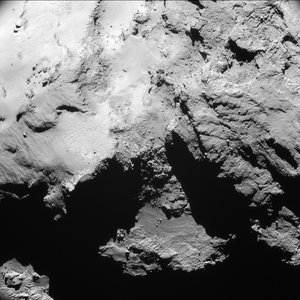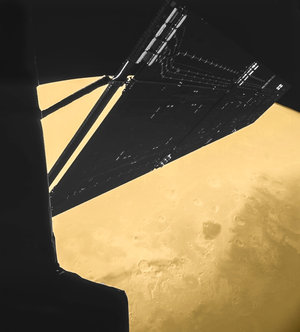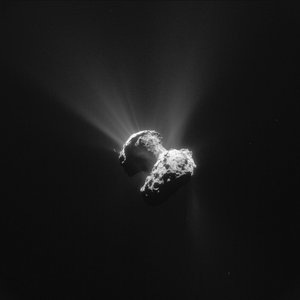Accept all cookies Accept only essential cookies See our Cookie Notice

About ESA
The European Space Agency (ESA) is Europe’s gateway to space. Its mission is to shape the development of Europe’s space capability and ensure that investment in space continues to deliver benefits to the citizens of Europe and the world.
Highlights
ESA - United space in Europe
This is ESA ESA facts Member States & Cooperating States Funding Director General Top management For Member State Delegations European vision European Space Policy ESA & EU Space Councils Responsibility & Sustainability Annual Report Calendar of meetings Corporate newsEstablishments & sites
ESA Headquarters ESA ESTEC ESA ESOC ESA ESRIN ESA EAC ESA ESAC Europe's Spaceport ESA ESEC ESA ECSAT Brussels Office Washington OfficeWorking with ESA
Business with ESA ESA Commercialisation Gateway Law at ESA Careers Cyber resilience at ESA IT at ESA Newsroom Partnerships Merchandising Licence Education Open Space Innovation Platform Integrity and Reporting Administrative Tribunal Health and SafetyMore about ESA
History ESA Historical Archives Exhibitions Publications Art & Culture ESA Merchandise Kids Diversity ESA Brand Centre ESA ChampionsSpace in Member States
Find out more about space activities in our 23 Member States, and understand how ESA works together with their national agencies, institutions and organisations.
Science & Exploration
Exploring our Solar System and unlocking the secrets of the Universe
Go to topicAstronauts
Missions
Juice Euclid Webb Solar Orbiter BepiColombo Gaia ExoMars Cheops Exoplanet missions More missionsActivities
International Space Station Orion service module Gateway Concordia Caves & Pangaea BenefitsLatest
Space Safety
Protecting life and infrastructure on Earth and in orbit
Go to topicAsteroids
Asteroids and Planetary Defence Asteroid danger explained Flyeye telescope: asteroid detection Hera mission: asteroid deflection Near-Earth Object Coordination CentreSpace junk
About space debris Space debris by the numbers Space Environment Report In space refuelling, refurbishing and removingSafety from space
Clean Space ecodesign Zero Debris Technologies Space for Earth Supporting Sustainable DevelopmentLatest
Applications
Using space to benefit citizens and meet future challenges on Earth
Go to topicObserving the Earth
Observing the Earth Future EO Copernicus Meteorology Space for our climate Satellite missionsCommercialisation
ESA Commercialisation Gateway Open Space Innovation Platform Business Incubation ESA Space SolutionsEnabling & Support
Making space accessible and developing the technologies for the future
Go to topicBuilding missions
Space Engineering and Technology Test centre Laboratories Concurrent Design Facility Preparing for the future Shaping the Future Discovery and Preparation Advanced Concepts TeamSpace transportation
Space Transportation Ariane Vega Space Rider Future space transportation Boost! Europe's Spaceport Launches from Europe's Spaceport from 2012Latest

Comet on 14 February from 8.7 km
Thank you for liking
You have already liked this page, you can only like it once!
On 14 February 2015, Rosetta swooped over the surface of Comet 67P/Churyumov–Gerasimenko at a distance of just 6 km. The closest approach took place at 12:41 GMT over a region known as Imhotep, which is on the larger of the comet’s two lobes.
The image reveals the contrasting terrains seen on this comet. Layered and fractured exposed surfaces contrast against expanses of smooth, dust-covered terrain. In some places, such as to the lower right of this image, the faint outline of raised near-circular objects with smooth surfaces can be seen. Elsewhere, boulders ranging in size from a few metres to a few tens of metres are scattered across the surface. The largest boulder, seen to the upper right, is named Cheops.
As well as providing the opportunity to take close-up high-resolution images of the surface, flybys like this also allow Rosetta’s instruments to sample the innermost parts of the comet’s atmosphere, or coma, to understand the connection between the source of the observed activity and the wider coma.
The spacecraft has now begun a new phase of observations, whereby it will continue to fly past at a range of distances, typically between about 15 km and 100 km.
The more distant flybys will provide the broader context of a wide-angle view of the nucleus and its growing coma as the comet moves towards perihelion – the closest approach to the Sun along its orbit. Rosetta is today 345 million kilometres from the Sun; at perihelion, on 13 August this year, it will be at about 186 million kilometres, between the orbits of Earth and Mars.
The image presented here was taken with the navigation camera shortly after closest approach, at 14:19 GMT, from a distance of 8.7 km. It has a scale of 0.74 m/pixel and measures 0.76 km across.
More images from the flyby are available via the blog: CometWatch 14 February – flyby special
This work is licenced under the Creative Commons Attribution-ShareAlike 3.0 IGO (CC BY-SA 3.0 IGO) licence. The user is allowed to reproduce, distribute, adapt, translate and publicly perform this publication, without explicit permission, provided that the content is accompanied by an acknowledgement that the source is credited as 'European Space Agency – ESA', a direct link to the licence text is provided and that it is clearly indicated if changes were made to the original content. Adaptation/translation/derivatives must be distributed under the same licence terms as this publication. To view a copy of this license, please visit http://creativecommons.org/licenses/by-sa/3.0/igo/
-
CREDIT
ESA/Rosetta/NavCam – CC BY-SA IGO 3.0 -
LICENCE
ESA Standard Licence

Year at a comet, February 2015

Spacecraft shadow

Rosetta’s self-portrait at Mars

Comet 67P/CG on 5 Oct 2013















 Germany
Germany
 Austria
Austria
 Belgium
Belgium
 Denmark
Denmark
 Spain
Spain
 Estonia
Estonia
 Finland
Finland
 France
France
 Greece
Greece
 Hungary
Hungary
 Ireland
Ireland
 Italy
Italy
 Luxembourg
Luxembourg
 Norway
Norway
 The Netherlands
The Netherlands
 Poland
Poland
 Portugal
Portugal
 Czechia
Czechia
 Romania
Romania
 United Kingdom
United Kingdom
 Slovenia
Slovenia
 Sweden
Sweden
 Switzerland
Switzerland
























